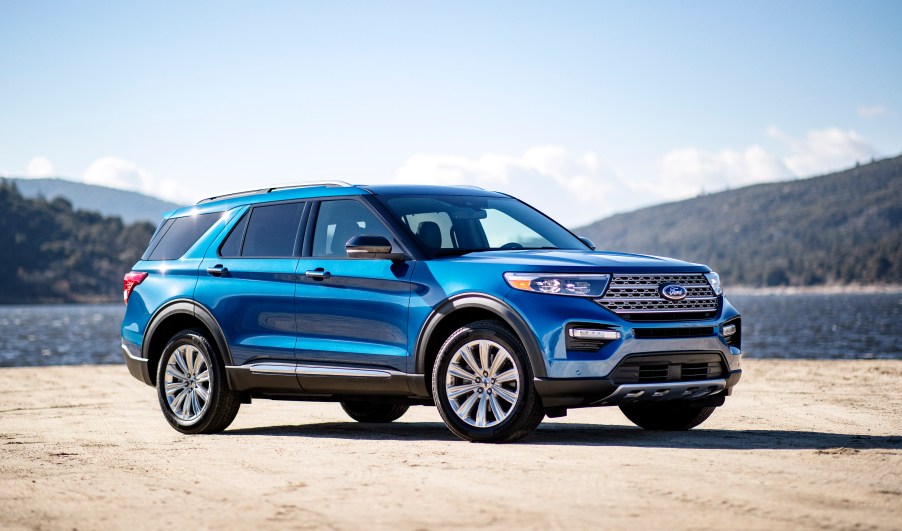
How Reliable Is the Ford Explorer?
Although the Ford Explorer has enjoyed a long reign on the American SUV landscape, it’s not been without its share of recalls, complaints, and overall design issues.
Unfortunately, with a history that extends back to 1991, encompassing six generations of production, each version holds its own distinct idiosyncrasies. A look at the highs and lows the iconic Ford Explorer provides the SUV-adoring public some insight into the model’s overall reliability.
1st and 2nd generations: 1991 – 2001
It’s hard not to revisit the first years of the Explorer’s production without mention of the Firestone tire blowout debacle and the SUV’s subsequent propensity for rollovers. While the tread separation was the mitigating factor that caused drivers to overcompensate for the loss of steering control in a tire blowout, the incidence of vehicular rollovers created mounting concern.
The US National Highway Traffic Safety Administration‘s investigation finally concluded that, because of the high center of gravity, the Ford Explorer was no more disposed to rollovers than other SUVs. Ford eventually replaced millions of Firestone tires and introduced electronic steering control.
Beginning with the second generation (1995), the Ford Explorer’s 4.0L SOHC V6 engine’s plastic OEM timing chain guides, tensioners, and cassettes have been notorious for breaking. The resulting timing chain tick is noticeable as early as 45,000 miles. Timing jump, complete engine shutdown, and damaged heads and valves are common results if the breakage is left unchecked.
The 5R55 series transmissions introduced in the second generation also began a long history of failure complaints. Problems are attributed to excessive valve body, transmission case, and servo pin bore wear.
3rd generation: 2002 – 2005
The Explorer’s transmission issues continued to plague the automaker, with 2002 cited as the worst year for the production of the vehicle. In fact, more than 16 crashes were attributed to transmission malfunction. The transmission’s reported fires led to the moniker “Ford Exploder.”
While transmission issues were the overarching concern for the third generation, it certainly wasn’t the only problem. Cars.com tallied reliability complaints ranging from wheel and hub problems related to bearing failure to drivetrain concerns mainly attributed to the rear differential.
Like the transmission, the plastic OEM timing chain apparatus breakage also continued through the model’s third generation.
4th generation: 2006 – 2010
What marked the beginning of the fourth generation in 2006 had been largely addressed by production’s end in 2010. Transmission and OEM plastic timing part breakage were major concerns in 2006 as were cooling system leaks and engine failure.
By the end of the generation, however, such complaints were minimal. Wheel bearing wear and drivetrain concerns remained.
5th generation: 2011 – 2019
With transmission issues addressed, it still doesn’t equate to smooth sailing or a smooth ride as the case may be. New concerns about exhaust leaks and the subsequent high levels of carbon monoxide reported in the vehicles’ cabs have created a new chapter of reliability dialogue concerning the Ford Explorer.
Several lawsuits have been mounted against the automaker, including complaints lodged by police officers. One class-action suit concerning the 2010 to 2015 models is still in play.
The generation began on a high note with 2011 earning top marks in safety from the Insurance Institute for Highway Safety (IIHS). By 2016, however, reports of engine stalling and steering issues led Consumer Reports to rate the model year with a score of 1 out of 5 on their reliability scale.
6th generation: 2020 +
So far, the Explorer doesn’t seem to have rounded the corner of flawless design. While public interest in the redesigned 2020 model is high, the fact is IIHS has a different perspective. It received one acceptable rating for the driver-side overlap front test, leaving the Explorer off the Top Safety Pick rating list.
While the IIHS gives Ford credit for making improvements in footwell safety, it’s not enough to protect the driver’s leg from injury in a collision.
The bottom line
Ford has certainly produced reliable vehicles during its reign as a perennial favorite among the auto-buying public. Even the Explorer has had some good years; however, it’s continued production seems to have been marked by one problematic event after another.


